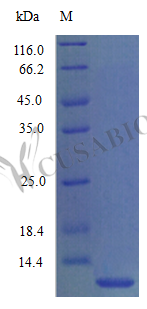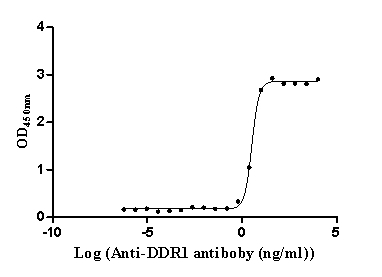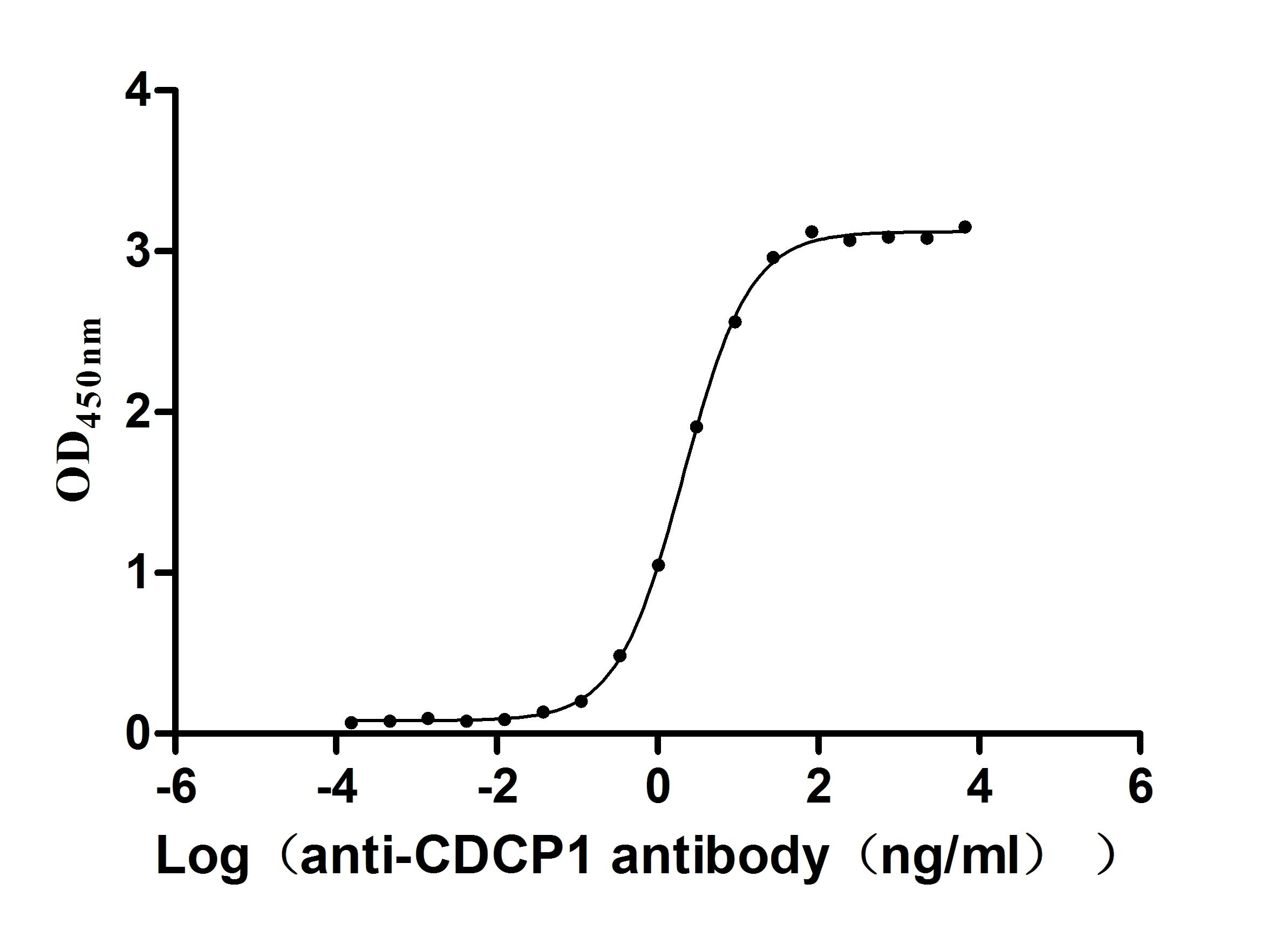Recombinant Mouse C-C motif chemokine 3 protein (Ccl3)
In Stock-
货号:CSB-AP001221MO
-
规格:¥2124
-
图片:
-
其他:
产品详情
-
纯度:>98% as determined by SDS-PAGE.
-
内毒素:Less than 1.0 EU/μg as determined by LAL method.
-
生物活性:Fully biologically active when compared to standard. The biological activity determined by a chemoattract bioassay using murine splenocytes is in a concentration range of 10-100 ng/ml.
-
基因名:
-
Uniprot No.:
-
别名:Ccl3; Mip1a; Scya3C-C motif chemokine 3; Heparin-binding chemotaxis protein; L2G25B; Macrophage inflammatory protein 1-alpha; MIP-1-alpha; SIS-alpha; Small-inducible cytokine A3; TY-5
-
种属:Mus musculus (Mouse)
-
蛋白长度:Full Length of Mature Protein
-
来源:E.Coli
-
分子量:7.9 kDa
-
表达区域:24-92aa
-
氨基酸序列APYGADTPTA CCFSYSRKIP RQFIVDYFET SSLCSQPGVI FLTKRNRQIC ADSKETWVQE YITDLELNA
-
蛋白标签:Tag-Free
-
产品提供形式:Liquid or Lyophilized powder
Note: We will preferentially ship the format that we have in stock, however, if you have any special requirement for the format, please remark your requirement when placing the order, we will prepare according to your demand. -
缓冲液:0.2 μm filtered concentrated solution in 30 % Acetonitrile and 0.1 % TFA,Lyophilized
-
储存条件:Store at -20°C/-80°C upon receipt, aliquoting is necessary for mutiple use. Avoid repeated freeze-thaw cycles.
-
保质期:The shelf life is related to many factors, storage state, buffer ingredients, storage temperature and the stability of the protein itself.
Generally, the shelf life of liquid form is 6 months at -20°C/-80°C. The shelf life of lyophilized form is 12 months at -20°C/-80°C. -
货期:5-10 business days
-
Datasheet & COA:Please contact us to get it.
相关产品
靶点详情
-
功能:Monokine with inflammatory, pyrogenic and chemokinetic properties. Has a potent chemotactic activity for eosinophils. Binding to a high-affinity receptor activates calcium release in neutrophils.
-
基因功能参考文献:
- During early remission from methamphetamine (MA), model mice exhibited increased anxiety-like behavior and reduced expression of chemokine (C-C motif) ligand 3 (ccl3) in the hippocampus relative to saline-treated mice. Human adults actively dependent on MA and those in early remission had elevated symptoms of anxiety as well as reductions in plasma levels of CCL3, relative to adults with no history of MA abuse. PMID: 29402784
- miR-125b could play an important role in inflammatory injury of chondrogenic cells and miR-125b affected inflammatory injury of ATDC5 cells via regulating expression of MIP-1alpha and regulating NF-kappaB and JNK signaling pathways. PMID: 29550827
- Leukemogenic effects of the Ptpn11E76K/+mutation in the stem-cell microenvironment is abolished in Ptpn11E76K/+Prx1-Cre+CCL3-/- mice, indicating that CCL3 is important for leukemic transformation. PMID: 28751523
- Parenchymal polymorphonuclear myeloid-derived suppressor cell (PMN-MDSC), have a positive correlation with IL1a, IL8, CXCL5, and Mip-1a, suggesting they may attract PMN-MDSC into the tumor PMID: 27799249
- CCL3 plays a significant role in the clearance of infection and resolution of otitis media inflammation and contributes to mucosal host defense of the nasopharyngeal niche, a reservoir for middle ear and upper respiratory infections. PMID: 28847849
- Cytokine array analysis demonstrated that the chemokine CCL3 was elevated in the plasma of AML mice and patients. CCL3 inhibited erythroid differentiation of hematopoietic stem cells, common myeloid progenitors and especially megakaryocytic-erythroid progenitors. PMID: 27109512
- MCP chemokines are activated in peripheral tissues of breast cancer-bearing mice, by a mechanism that involves breast cancer cell-derived Ccl3. PMID: 28041977
- These observations suggest that intra-BM basophil expansion can favor leukemia-tropic hematopoiesis in myeloid leukemia by providing CCL3, a potent inhibitor of normal hematopoiesis and that basophil-derived CCL3 may be a novel target molecule for the treatment of myeloid leukemia. PMID: 27006388
- A marked increase of CCL3 mRNA expression was observed in inflamed paws, with CCL3 protein detected in neutrophils and macrophages by immunohistochemical experiments. PMID: 26663750
- CCL2/CCL3 double-mutant animals are viable, fertile, and do not present with gross abnormalities. Cuprizone increased CCL3 expression in wild-type but not mutant mice. Cuprizone-induced demyelination, oligodendrocyte loss, and astrogliosis were significantly ameliorated in the cortex but not corpus callosum of chemokine-deficient animals. PMID: 25663168
- these data suggest that the chemokine CCL3 is an hippocampal neuromodulator able to regulate synaptic plasticity mechanisms involved in learning and memory functions. PMID: 26511387
- Ccl3 mRNAs increased within 5 h after injury in mouse cortical slices. PMID: 25895671
- Previous exposure to noninjurious ventilation induces a state of tolerance to ventilator-induced lung injury. Down regulation of the chemokine gene Ccl3 could be the mechanism responsible for this effect. PMID: 26472813
- the tissue fibrinolytic system contributes to the induction of macrophage recruitment and CCL3 at the bone injury site, thereby, leading to the enhancement of the repair process. PMID: 25893677
- APOE varepsilon4 genotype specifically modulates astrocyte secretion of potent microglial chemotactic agents, including CCL3 PMID: 25092803
- In experimental autoimmune encephalomyelitis there was a significant increase in activation of astrocytes with increased MIP-1alpha expression. PMID: 24989845
- Negative modulation of PGE2 signaling reduced infection-induced anti-inflammatory cytokine polarization and enhanced inflammatory chemokines, CCL3 and CCL5. PMID: 25049356
- Granzyme M regulates the release of natural killer cell MIP-1alpha to initiate innate immune responses. PMID: 24625974
- CCL3-CCR5-mediated fibroblast accumulation may be required, in addition to leukocyte infiltration, to induce full-blown colitis-associated carcinogenesis. PMID: 24510316
- CCL3 production by microglial cells modulates disease severity in murine models of retinal degeneration. PMID: 24639355
- results define the chemokine CCL3 as a mediator of experimental liver fibrosis. Thus, therapeutic modulation of CCL3 might be a promising target for chronic liver diseases PMID: 23799074
- BCR-ABL(+)lineage(-)c-kit(-) immature leukemia cells produced high levels of an inflammatory chemokine, MIP-1alpha/CCL3, which promoted the development of chronic myeloid leukemia. PMID: 24166712
- The CCR5/MIP-1alpha axis may contribute to migration of infected cells to the brain and consequently affect the pathogenesis during Rocio virus infection. PMID: 24080631
- Data indicate that Bifidobacterium infantis feeding to Salmonella-infected mice significantly reduced Peyer's patch MIP-1alpha and MIP-1beta secretion. PMID: 23648818
- IFN-gamma and NOS2 repress CCL3 and CCL4 in vivo upon S. typhimurium infection of mice also repress CCL3 and CCL4 during S. typhimurium infection in bone marrow-derived macrophages. PMID: 23431040
- Under conditions of acute inflammation leukocyte-derived CCL3 can induce neutrophil chemotaxis toward the atherosclerotic plaque, thereby accelerating lesion formation. PMID: 23288165
- findings show that CCR1 is pivotal for bone remodeling induced by mechanical loading during orthodontic tooth movement and these actions depend, at least in part, on CCL3 PMID: 23059626
- Hyperocclusion induced compensatory CCL3 expression; promoted osteoclastogenesis to counterbalance deficient CCL2/CCR2 signaling. co-expression of CCL3 with CCL2 may precipitate synergistic, MS-dependent alveolar destruction during occlusal traumatism. PMID: 23143790
- The kinetics and extent of microglia and astrocyte activation during early and late cuprizone-induced demyelination in the white matter tract corpus callosum and the telencephalic gray matter were related to the expression of the Ccl2 and Ccl3. PMID: 22528463
- Expression of ALDH1A2, BEX2, EGR2, CCL3 and PLAU are upregulated in Toxoplasma gondii susceptible C57BL/6 mice. PMID: 22451728
- role for CCL3 in lipid metabolism in hyperlipidemic mice following hematopoietic reconstitution. PMID: 22359597
- In a murine carotid aneurysm model of vascular inflammatory repair, monocyte chemotactic protein (MCP)-1-mediated tissue in-growth occurs via a MIP-1alpha- and MIP-2-regulated pathway. PMID: 22007074
- our data indicate that the interaction between TTP and CCL3 mRNA plays an important role in modulating localized inflammatory processes in tissues that are dissociated from the systemic manifestations of chronic inflammation. PMID: 21784977
- The selective interaction of CCL3 with its receptor, CCR1, is critical for radiation-induced lung inflammation and fibrosis, and these conditions can be largely prevented by a small molecule inhibitor of CCR1 PMID: 20870892
- Absence of TLR3 in skin-injured mice leads to defective recruitment of neutrophils and macrophages, in association with decreased expression of the chemokines MIP-2/CXCL2, MIP-1alpha/CCL3, and MCP-1/CCL2 in the wound. PMID: 21317384
- MIP-1alpha and interferon-gamma production by CD1d-restricted natural killer (NK)T cells contributes to immune complex-induced acute lung injury. PMID: 21191075
- Maternal cells can migrate through the blood-placenta barrier even in the absence of fetal CCL3 in mice. PMID: 20567093
- This work demonstrates that the development of F. hepatica is not affected by the absence of CCL3. PMID: 20643506
- These results suggest that peripheral nerve injury elicits the up-regulation of spinal MIP-1alpha and CCR1 to participate in neuropathic pain. PMID: 20692319
- results suggest a close association between the MIP-1alpha response and the Th1-type T-cell responses in chlamydial lung infections PMID: 20622889
- Results show that CCL3 regulates the balance of T cell populations in the lung and can alter the outcome of RSV infection. PMID: 20195359
- In conclusion, we propose a novel critical molecule MIP-1alpha derived from macrophages and Schwann cells that appears to play a crucial role in the development of neuropathic pain induced by PSL. PMID: 20223588
- OGT could be a co-regulatory subunit shared by functionally distinct complexes supporting epigenetic regulation of MIP-1alpha gene promoter. PMID: 20206135
- Studies demonstrate that CCL3 plays a major role in mediating GVHD, but not graft-versus-leukemia. PMID: 20100934
- CCL3 is a potent downstream effector of tumor necrosis factor-mediated inflammation in vitro and in vivo. PMID: 20164426
- we identified a novel role for neutrophil-secreted CCL3 in the first wave of dendritic cells recruitment to the site of infection with L. major PMID: 20140197
- Data verified that the expression of CCR5 and its ligands, CCL3, CCL4 and CCL5, were increased in the thymus with age. PMID: 20046229
- MIP-1a is the key substrate in the lung for matrix metalloproteinase-8 during lipopolysaccharide-mediated acute lung injury in mice. PMID: 20042585
- GA exhibits antiinflammatory effects through inhibition of MIP-1alpha in a mouse model of acute P. acnes-induced inflammatory liver injury. PMID: 19897483
- MIP-1alpha, MIP-1beta, RANTES, and ATAC/lymphotactin function together with IFN-gamma as type 1 cytokines. PMID: 11972057
收起更多
-
亚细胞定位:Secreted.
-
蛋白家族:Intercrine beta (chemokine CC) family
-
组织特异性:Expressed in lung, spleen, and pancreas.
-
数据库链接:
KEGG: mmu:20302
STRING: 10090.ENSMUSP00000001008
UniGene: Mm.1282








f4-AC1.jpg)












